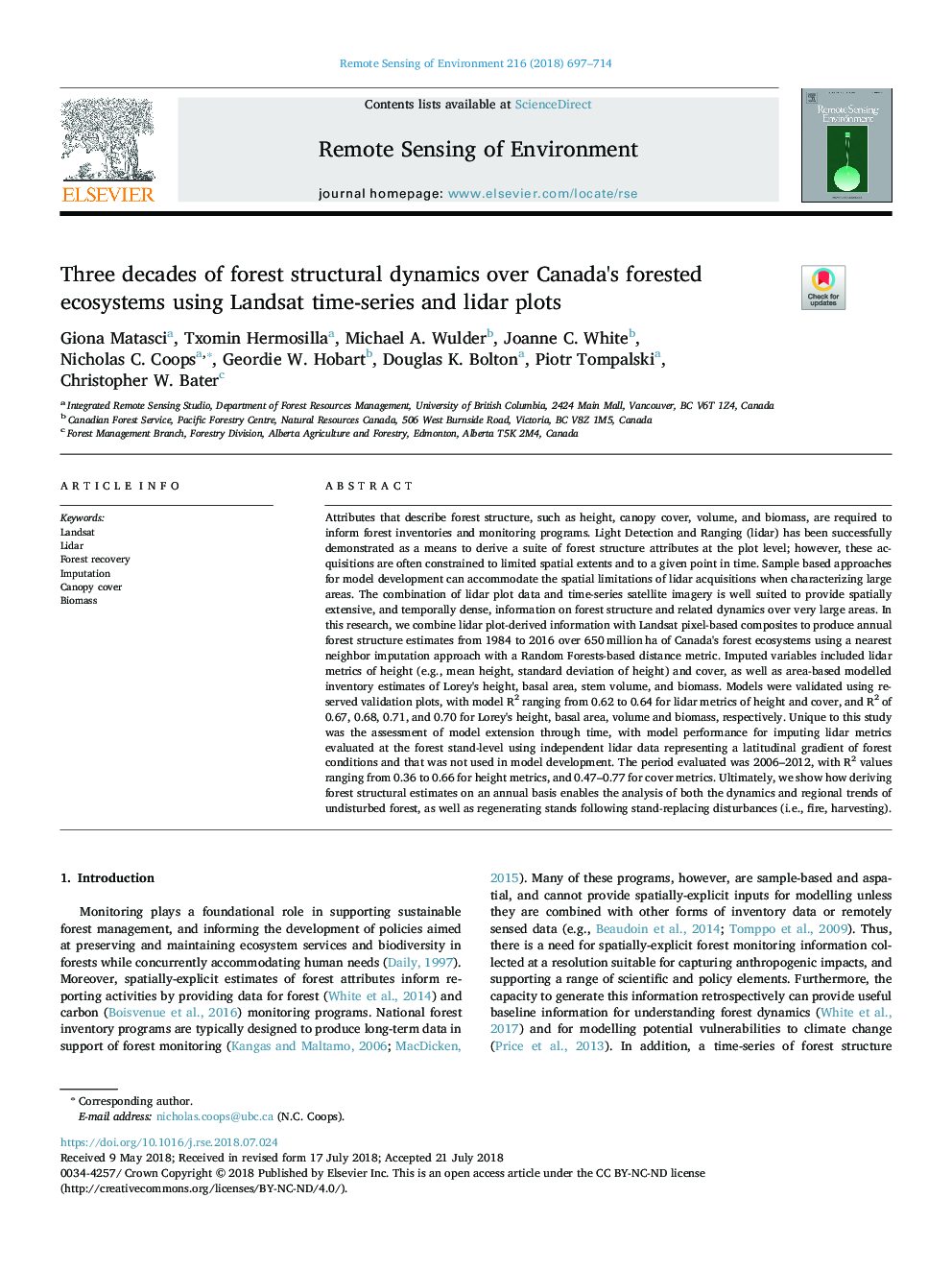| کد مقاله | کد نشریه | سال انتشار | مقاله انگلیسی | نسخه تمام متن |
|---|---|---|---|---|
| 8866447 | 1621184 | 2018 | 18 صفحه PDF | دانلود رایگان |
عنوان انگلیسی مقاله ISI
Three decades of forest structural dynamics over Canada's forested ecosystems using Landsat time-series and lidar plots
ترجمه فارسی عنوان
سه دهه از دینامیک ساختاری جنگل بیش از اکوسیستم های جنگل کانادا با استفاده از لندست در زمان سری و لیدار
دانلود مقاله + سفارش ترجمه
دانلود مقاله ISI انگلیسی
رایگان برای ایرانیان
کلمات کلیدی
لندست، لیادور، بازیابی جنگل، تقلب، پوشش سایبان، زیست توده،
موضوعات مرتبط
مهندسی و علوم پایه
علوم زمین و سیارات
کامپیوتر در علوم زمین
چکیده انگلیسی
Attributes that describe forest structure, such as height, canopy cover, volume, and biomass, are required to inform forest inventories and monitoring programs. Light Detection and Ranging (lidar) has been successfully demonstrated as a means to derive a suite of forest structure attributes at the plot level; however, these acquisitions are often constrained to limited spatial extents and to a given point in time. Sample based approaches for model development can accommodate the spatial limitations of lidar acquisitions when characterizing large areas. The combination of lidar plot data and time-series satellite imagery is well suited to provide spatially extensive, and temporally dense, information on forest structure and related dynamics over very large areas. In this research, we combine lidar plot-derived information with Landsat pixel-based composites to produce annual forest structure estimates from 1984 to 2016 over 650â¯millionâ¯ha of Canada's forest ecosystems using a nearest neighbor imputation approach with a Random Forests-based distance metric. Imputed variables included lidar metrics of height (e.g., mean height, standard deviation of height) and cover, as well as area-based modelled inventory estimates of Lorey's height, basal area, stem volume, and biomass. Models were validated using reserved validation plots, with model R2 ranging from 0.62 to 0.64 for lidar metrics of height and cover, and R2 of 0.67, 0.68, 0.71, and 0.70 for Lorey's height, basal area, volume and biomass, respectively. Unique to this study was the assessment of model extension through time, with model performance for imputing lidar metrics evaluated at the forest stand-level using independent lidar data representing a latitudinal gradient of forest conditions and that was not used in model development. The period evaluated was 2006-2012, with R2 values ranging from 0.36 to 0.66 for height metrics, and 0.47-0.77 for cover metrics. Ultimately, we show how deriving forest structural estimates on an annual basis enables the analysis of both the dynamics and regional trends of undisturbed forest, as well as regenerating stands following stand-replacing disturbances (i.e., fire, harvesting).
ناشر
Database: Elsevier - ScienceDirect (ساینس دایرکت)
Journal: Remote Sensing of Environment - Volume 216, October 2018, Pages 697-714
Journal: Remote Sensing of Environment - Volume 216, October 2018, Pages 697-714
نویسندگان
Giona Matasci, Txomin Hermosilla, Michael A. Wulder, Joanne C. White, Nicholas C. Coops, Geordie W. Hobart, Douglas K. Bolton, Piotr Tompalski, Christopher W. Bater,
